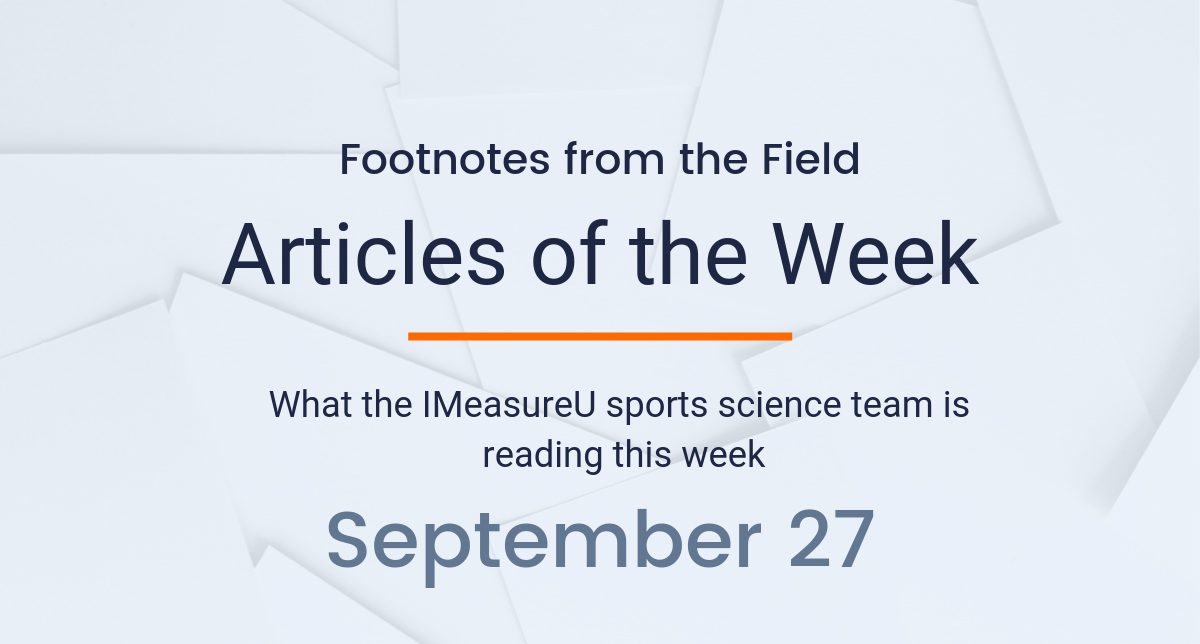
Here’s what the sports science team at IMeasureU is reading this week:
Landing mechanics, deceleration and their relationship to injury risk is a hot topic at the minute in both academic and applied circles. Tyler Collings and colleagues at the Queensland Academy of Sport in their paper for the Journal of Science and Medicine in Sport examined whether young high performance netball players exhibited different landing mechanics compared to females who do not compete in sports which require frequent landings. Collings et al. (2019) concluded that the high-performance netball players had less knee extensor contribution to work during the landing phase compared to athletes with minimal experience playing a landing sport. However values for knee valgus and internal rotation were not significantly different between the groups leading the authors to conclude that both groups displayed relatively high values in key risk factors for ACL injury. Therefore low risk landing mechanics may not arise from playing experience alone and targeted training interventions should be put in place to reduce landing risk factors.
The next article comes from author Ryan Curtis and colleagues at the University of Connecticut in the Journal of Strength and Conditioning Research. This study investigated factors influencing training loads in collegiate men’s soccer. Total distance, high-speed running distance, high-intensity heart-rate zone duration, and session rating of perceived exertion were looked at in over 100 players across 5 NCAA Division 1 teams. Interesting conclusions were drawn based on the results which included that training load increased immediately after losses and also when training sessions occured more than 5 days from a match. This information has implications for practitioners who are planning and periodising training sessions and recovery strategies.
This article in the Journal of Sports Sciences, author Athos Trecroci and colleagues at the Università degli Studi di Milano, Italy in the Journal of Strength and Conditioning Research. In a competitive soccer season, players are often expected to perform after very little recovery time from the previous match, sometimes as little as 2 days. Therefore, the aim of this article was to examine how muscle function of knee extensors and flexors and sprint performance recovered +72 hours after match in relation to different field-based training sessions. They concluded that becausemuscle fatigue has been related with increased hamstring injury risk, a training based on active recovery can be a valid intervention to promote the recovery of muscle force production of knee flexors and reduce hamstring injury risk in the short postmatch period.
Our fourth article comes from Naokazu Miyamoto and colleagues from Juntendo University in Japan. It features in the Medicine & Science in Sports & Exercise Journal and aims to identify the characteristics of muscle stiffness in sprinters and long-distance runners, and to determine how muscle stiffness is related to the performance of these athletes. In brief, the authors concluded that passive and active muscle stiffness may play different roles in human locomotion, depending on locomotion speeds and that sprinters and long distance runners exhibit stiffness characteristics that can be beneficial to their athletic performance.
The last article in this week’s articles of the week comes from Blanca Romero-Moraleda in the Journal of Human Kinetics. This topic has been very much in the public eye since the the USA won the womens soccer world cup this summer and publicised how they had tracked each players mentrual cycle to maximise performance and recovery. However this paper aimed to investigate the fluctuations of muscle performance in the Smith machine half-squat
exercise during three different phases of the menstrual cycle. The results of this study suggest that there was no difference in strength and power characteristics during each phase of the mentrual cycle. However, the authors were keen to stress that these results do not dispute the notion that hormone fluctuations during the menstrual cycle may influence hallmark adaptations to long-term RT such as increased strength and muscle hypertrophy.
For more sports science check out our blog for in-depth case studies and industry updates. Also, be sure to sign up for our newsletter below so you are always up to date with the latest research.




